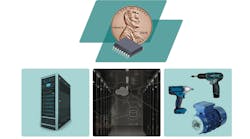High-Power Current Sensors Primed for Automotive, Industrial Power Apps
This article appeared in Microwaves & RF and has been published here with permission.
Check out more of our APEC 2023 coverage.
In its Booth #863 at APEC 2023, ACEINNA is unveiling its latest high-power current-sensing devices. The company’s MCx2101 (AEC-Q100 qualified automotive) and MCx1101 (industrial) isolated AMR current sensors are said to maximize the benefits of using SiC/GaN and help further increase the overall power-conversion efficiency while improving the safety thanks to their industry-leading high accuracy, high bandwidth, and fast response time.
The sensors are used in broad number of applications ranging from solar-panel inverters, wind turbines, data-center power supplies, motor drivers in industrial and on-board chargers and fast dc chargers, traction inverters and various power-supply and conversion applications in automotive use cases. In many such applications, silicon-carbide (SiC) and gallium-nitride (GaN) power transistors are replacing silicon MOSFETs. These new transistors are enabling higher-frequency systems with better efficiency and smaller size.
When developing power solutions using these higher frequencies, engineers require a higher-bandwidth current sensor for the current-control loop. Totem-pole power-factor correction (PFC) requires fast-switching ripple current measurements, as do motor and inverter applications. Higher-bandwidth sensors also enable fast step response in protection circuits.
The 1.5-MHz frequency response of ACEINNA’s current sensors enables SiC/GaN advantages such as higher frequency, smaller system size, and better system efficiency. Their benchmark step-response time (300 ns) minimizes protection timing budget for current sensors and enables the protection of higher-frequency SiC/GaN switches. Benchmark accuracy (0.6% typical) over temperature for ICs provides better control and regulation to improve efficiency and reliability. The sensors’ low offset and low noise provides high accuracy across the dynamic range.
Check out more of our APEC 2023 coverage.

